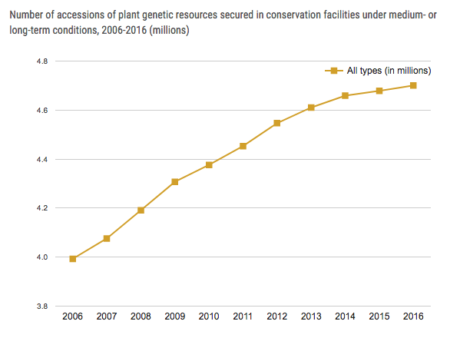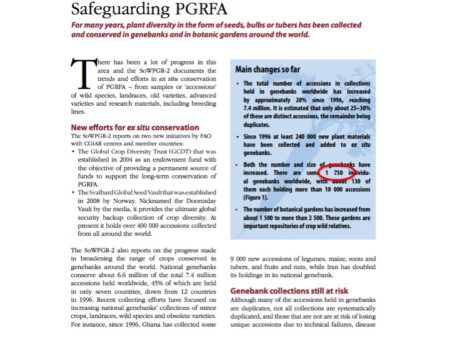- There’s a genebank for algae and protozoans.
- How Turkey Red Wheat from Ukraine built Kansas.
- Taming the wild blueberry.
- History of the ugliest dog breed in the world.
- The prairie lives on among the dead.
- Speaking of which: land tenure and conservation.
- Conserving and breeding sunflowers in the US.
- Making potato breeding great again.
- M.S. Swaminathan recommends millets.
- Computing our way to food security.
- Food insecurity and migration.
Brainfood: Mycorrhizal diversity, Olive diversity, Teak diversity, Core software diversity, Cost-benefit, Frosty rye, CGIAR future, Portuguese beans, Improvement networks, Food sovereignty
- Historical biome distribution and recent human disturbance shape the diversity of arbuscular mycorrhizal fungi. Proximity to tropical grasslands during the last glacial maximum makes for a large potential species pool, remoteness from human disturbance for the presence of a high percentage of that pool.
- The First Molecular Identification of an Olive Collection Applying Standard Simple Sequence Repeats and Novel Expressed Sequence Tag Markers. 59 genotypes among 370 trees.
- Worldwide translocation of teak—origin of landraces and present genetic base. The dryer part of the natural range has not really been used in plantations.
- GenoCore: A simple and fast algorithm for core subset selection from large genotype datasets. Better than MSTRAT, Core Hunter, and random sampling.
- Global economic trade-offs between wild nature and tropical agriculture. We can go ahead and cut down the Atlantic Forest. Wait, what?
- Exploring new alleles for frost tolerance in winter rye. Basically one allele, actually.
- Reforming the research policy and impact culture in the CGIAR: Integrating science and systemic capacity development. Let CGIAR be CGIAR.
- Improving global integration of crop research. Taking this to the next level. Which sounded a lot like the International Treaty’s Global Information System on PGRFA. Also, see above.
- Establishing the Bases for Introducing the Unexplored Portuguese Common Bean Germplasm into the Breeding World. 37 accessions had 100% of the diversity of 175 accessions, which were mainly hybrids between the two main genepools. I don’t think I’ve ever seen that before.
- Plant diversity increases with the strength of negative density dependence at the global scale. Janzen-Connell were right, it’s natural enemies that explain the tropical-temperate diversity pattern. With video goodness.
- Local food sovereignty for global food security? Highlighting interplay challenges. “…scaling up of food sovereignty will not necessarily lead to wider sustainability and food security outcomes.”
Nibbles: Seed saving, Craft saving, Talking sweet potatoes, Breeding eggplants, Cat domestication, Cary on Svalbard, US apple book, US strawberries, Forages newsletter, Banana double
- 94% is the new 75%. Here’s some of the survivors.
- But how many crafts have we lost?
- Win a prize for communicating about sweet potatoes.
- Pre-breeding eggplants using their wild relatives.
- Two waves of cat domestication.
- Svalbard double.
- 350 buck’s worth of apple history.
- 10 cent’s worth of strawberry history.
- Latest newsletter from those nice forages genetic resources conservation folks.
- Bananas good and bad news.
Dueling congresses
The 28th International Congress for Conservation Biology (ICCB 2017), or the XIX International Botanical Congress (IBC 2017)? Thanks to Twitter, both. And next month the XXX International Horticultural Congress (IHC 2018), just for good measure.
Oh, and while we’re at it, Happy 50th Birthday to IITA.
How many genebanks are there in the world?
The UN Statistics Division (UNSD) is responsible for bringing together data on the Sustainable Development Goals, and does a generally pretty good job of explaining the just-agreed targets and indicators on its new(ish) website. Let’s remind ourselves that Goal 2 is: “End hunger, achieve food security and improved nutrition and promote sustainable agriculture.” And that Target 2.5 and its associated indicators are as follows:

The UNSD website presents the challenge under the heading: Increased efforts are needed to achieve the 2020 target on maintaining genetic diversity. But what’s the baseline? Here’s what it has to say specifically on genebanks (Indicator 2.5.1):
By the end of 2016, 4.7 million samples of seeds and other plant genetic material had been conserved in 602 gene banks across 82 countries and 14 regional and international centres. Over the past 11 years, the rate of increase in gene-bank holdings has slowed.
There’s even a graph:

These figures, however, are a bit of a departure from the ones we usually use, which come from the Second Report on the State of the World’s Plant Genetic Resources for Food and Agriculture (SoWPGR2). That said there were 7.4 million accessions in 1,750 genebanks in 2010. This is from the “synthetic account” of SoWPGR2, a kind of executive summary:
Have 1,148 genebanks up and disappeared? No, I don’t think so. What’s happened is that UNSD is using data from FAO’s ongoing efforts to monitor implementation of the Global Plan of Action on PGRFA, and prepare the third SoWPGR, and these are still incomplete, not all countries having reported yet (there’s a couple of years still to go on that process, but an update was provided to the FAO Commission on Genetic Resources for Food & Agriculture earlier this year). Likewise, 2 million-odd accessions have not gone up in smoke. It could be just incomplete data again. Or maybe UNSD is using data on Annex I crops only? The metadata behind the UNSD information on Target 2.5 refers to “unique” accessions in long- and medium-term conservation, rather than total number of accessions, so it could be that too. Here’s the relevant excerpt from SoWPGR2:
Based on figures from the World Information and Early Warning System (WIEWS) and country reports, it is estimated that about 7.4 million accessions are currently maintained globally, 1.4 million more than were reported in the first SoW report. Various analyses suggest that between 25 and 30 percent of the total holdings (or 1.9-2.2 million accessions) are distinct, with the remainder being duplicates held either in the same or, more frequently, a different collection.
Germplasm of crops listed under Annex I of the ITPGRFA is conserved in more than 1,240 genebanks worldwide and adds up to a total of about 4.6 million samples. Of these, about 51 percent is conserved in more than 800 genebanks of the Contracting Parties of the ITPGRFA and 13 percent is stored in the collections of the CGIAR centres.
Anyway, I’m sure all this will be sorted out in due course. Let’s not quibble. It’s difficult pulling these data together from dozens of countries, plus regional and international organizations as well, and just having genebanks recognized as crucial to the goal of ending hunger is pretty cool, no matter how you count them.
